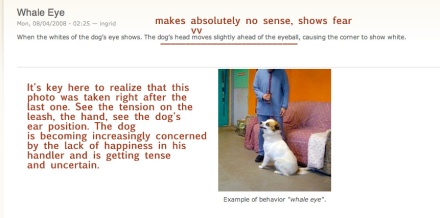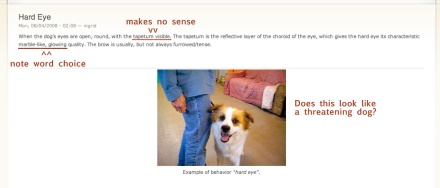Yesterday we looked at cropping (ears). As you may have seen from the comments, there’s a much stronger feeling against cropping than there is against docking.
This is really interesting, considering that docking actually removes more tissue, bone, and of course a whole bunch of the dog’s spinal cord; cropping just removes skin (and tissue and nerves and so on). Please don’t think I’m minimizing cropping; but in terms of physical trauma there’s no contest.
The reason, I think, that we tend to accept docking much more easily and even anti-cropping people will still dock their puppies is simply because it happens so early.
Docking is typically done when the puppies are just a few days old. Some breeders bring the puppies to the vet but most experienced breeders will dock the puppies themselves. This is done for the same reason that private croppers do ears – because very few vets are as much an expert on the breed as the breeder is, and experienced breeders are MUCH better than their vets at predicting growth. Several breeds are flattered most by tails that relate to the size of the adult dog – for example, that the tail end as high as the head, or in a specific proportion of the height of the dog. I was once in on a discussion of poodle tail length and it was like listening to an algebra class – the length of the tail and the size and shape of the tail pom in proportion to the dog’s body length, height, the rest of the groom, etc. is considered vital not just to the look of the dog but to the entire type and “poodliness” of the dog. It takes an experienced breeder to translate the fractions of an inch of a newborn puppy to the size and shape of the adult dog and to adjust each tail a centimeter up or down to meet the size and shape of the eventual dog.

Another reason breeders usually dock tails themselves is that even if the tail doesn’t relate to the size of the adult dog, tails in the show ring go through fads and fashions in the same way that grooming or markings do. These differences are usually completely invisible to a layperson but to breeders they are like a neon sign. A breeder can say that tails seem to be a half-inch longer or shorter this year and adjust the docking to meet this.
Vets usually dock tails surgically – by cutting. Depending on the breed a suture is placed in the end of the tail or it is glued or it is just left alone. Breeders who dock generally either tie off the tail (put a length of suture material or string or elastic or dental floss, depending on what they prefer, around the tail and then tying it tightly to cut off circulation to the tail) or band the tail (use a very strong, tight rubber band and an elastrator tool). Some cut the tails, others crush and twist them off; there are as many methods (and people firmly devoted to theirs as best) as there are breeders.
So WHY is this “no big deal”? I would imagine that if you were walking your adult Irish Setter around and someone walked over and cut off his tail (an inch from his anus) with a branch lopper, you would not think it was a minor event. But we’ve all bought the idea that it doesn’t matter because we’re cutting off such a little teeny thing.
Ask breeders who dock tails how they justify doing something so traumatic to the dog, and you will invariably get the same response: it doesn’t hurt them. The puppy’s nervous system is too immature to feel pain. The puppies barely squeak. They nurse and go to sleep right away. It’s over in a second. They will either follow this or preface it by saying that it’s in the standard, it’s the historical look of the dog, the dog just looks better this way, I love the little bunny butt, and so on.
I think that in addressing this we have to leave the aesthetics alone for a while, because they’re very much an individual thing. Some people think no tails are adorable, and it’s not like I can say “No they’re not!” Even if I believed that, appearance is pretty much by definition an “eye of the beholder” quality.
And I think that most people would agree that aesthetics only get to rule in a situation where there is no harm either way. I think short hair is attractive, I cut it. I think no nose is attractive, people would get a lot more heated about that.
Unless, of course, everyone thought that removing the nose was painless and harmless as long as you did it before the baby was a week old.
That’s pretty much exactly where we are in dogs. We may not like the idea of docking on a philosophical level, but we’re not going to make a big deal about it, because it “doesn’t hurt.”
Well, this is very tragically wrong.
Let’s look at the evidence for “it doesn’t hurt” one piece at a time. If you need specific studies referenced, let me know and I’ll give you my bibliography, but for the sake of time and flow I’m just going to write it out here. I promise that nothing I’m going to say is not backed up VERY CLEARLY by peer-reviewed studies.

1) The puppy’s nervous system is too immature to feel pain.
False. In fact, puppy pain response is so well established that it’s one of the tests used to determine whether the puppy is fit and vital. A study comparing traditional injectable, short-acting, and epidural anesthesia methods for performing c-sections on bitches demonstrated that short-acting was safer than injectable and epidural was safer than inhaled in no small part because the puppies’ PAIN RESPONSE was intact and immediate on the epidural bitches, acceptable in the short-acting-anesthesia bitches, and sluggish in the injectable-treated bitches.
Another argument is that the myelin around the puppies’ nerves is not fully developed, so they do not feel pain.
Again, this is false. This is the argument that subjected countless human babies to major surgeries without anesthesia, a practice that has (thankfully) ended now as we better understand the way nerves work. Myelin insulation makes the nerve impulses move faster, but its absence in no way prevents the animal, human or otherwise, from feeling pain. Human babies have pretty poor myelinization, but anybody who puts a baby into a bath that the baby thinks is too warm or too cool knows EXACTLY how well those skin receptors work. Even extremely premature human babies can feel and learn to anticipate heel sticks, which are not terribly traumatic.
Puppies know when they’re hot, cold, hungry, they know enough to want to put their heads up on something to feel more comfy when they sleep. An extremely light touch near a puppy’s nose will trigger rooting and sniffing. If they can feel when you move one of their whiskers, how on EARTH could they not feel it when you cut a third of their spinal cord off?

2) The puppy barely squeaks.
Again, this is no evidence. Vocalization is not just “I feel pain” or “I don’t feel pain.” Newborn animals, and this includes humans, will often react to pain by stopping a vocalization. When Zuzu fractured her skull, she barely cried. But there’s no way I’m going to say that based on that experience skull fractures don’t hurt. When the pain is sharp or shocking, baby animals will actually withdraw, quiet down, stop moving around, as their brains look for a way to deal with the pain and get comfort.
Which leads to
3) They nurse and go to sleep right away.
This is a CLASSIC example of a self-comforting behavior, a defense mechanism. Babies that are hurting nurse and sleep. An experienced mom can tell the difference between the frantic nursing of a hurt baby and the quiet and relaxed nursing of a content baby, but could you see that difference in a newborn puppy? I don’t think I could. But as an experienced human mom, I can tell you that the times that my kids have been in the most pain – Zuzu with her head, the time Tabitha fractured her tibia, and the time Honour put a tiny upholstery tack up her nose and the ER doc couldn’t get it and kept pushing and prying for over an hour and made her nose swell and bleed like bonkers (lesson to all moms: MAKE THEM PAGE THE ENT DOCTOR, who will get it out in less than two seconds), once the initial crying was over all three of them did nothing but nurse and sleep. They slept limp and hard; they were difficult to rouse. They slept on the x-ray table, every single one of them.
I tell those stories because I think the moms out there know this and recognize it in their own kids, not because I think dogs are humans. But can we generalize it to dogs? I think, demonstrably, yes. Many studies show that nursing and sleeping are a displacement mechanism across the animal kingdom, used as an adaptive behavior when the baby animal is in physical pain.
4) It’s over in a second.
This is the one that is the most poorly understood. We think that once the tail is gone, it’s gone. The pain is over.
But here’s the thing: You’ve removed a body part that is packed tight with nerves. When you cut those nerves, they do not just seal themselves off and sit there happily. They “know” where they’re supposed to go and how long they’re supposed to be, and when the cut ends try to heal they form massive, swollen tangles called neuromas. Neuromas are one of the causes of chronic amputated-limb pain in humans, and one of the reasons that many humans with amputations never really feel healed.
Neuromas have been studied pretty extensively in relation to the animals that are routinely killed within a few months of being docked – sheep (tails), pigs (tails) and chickens (beaks). In lambs, neuromas are found in the tail area even six months after docking (when the lambs are routinely slaughtered for food). In pigs, neuromas are present in the tail at full-market-weight slaughter. In chickens, neuromas are found when the chicken is a year and a half old, even though the beak was cut back when the chick was a day or two old. There are only a few small studies involving neuromas in docked dogs – because, of course, we don’t slaughter dogs – but the one study that examined three docked dogs euthanized for behavior problems found neuromas in the tail of all three, though they had been docked years before.

We can’t ask dogs whether they hurt. But we can say that we see neuromas associated with pain in humans, who can be asked, and we can say that docked dogs have neuromas that persist for years. Dogs are VERY stoic about pain, and they do not complain until the pain is pretty major. So while I’d never say that docked dogs remain in terrible pain forever, I think it’s quite plausible that they always have a bit of an ache, an itch, a twinge, far more often than we’d imagined.
So this is the situation. We have an aesthetic choice being made because it doesn’t hurt the dog. If we can demonstrate pretty clearly that it DOES hurt (and I think that’s inescapable) and there’s a strong possibility that it CONTINUES to hurt, at least a little, then how can we justify it?
This is where people start talking about the other reasons for docking, so let’s look at those:
5) Because it’s the historical appearance and meets the breed standards. And I agree with them! I am totally a traditionalist when it comes to purebred dog standards; I believe in them and I don’t want them changed for any but the most dire of reasons. I will defend the Pekingese club’s right to a short face until the day I die. But the standard MUST bend, I think it really must, when it comes to clear evidence of pain. You’ve GOT to rethink things when it’s not just the one in a hundred that hurts a leg because your breed is heavier than average, it’s 100 percent of your puppies having to be injured and then arguably feeling that injury for years to come.
In terms of historicity… that’s really a pretty poor argument. The dog must have existed before you started docking it, so (obviously) at one point, before it was docked, it was undocked. So not docking is earlier than docking. Going back to not docking is truer to the very earliest existence of the breed.
6) It prevents injuries in working dogs. This one is the argument I always cough into my hand at – to prevent injuries, we deliberately inflict an injury? And that’s OK? Carpenters usually have hands that look like they’re a complete mess, tons of cuts and scratches. Should we amputate their hands to prevent those injuries? This argument also falls on the grounds of the hundreds of thousands of working dogs who KEEP their tails – Border Collies, the livestock guardian dogs, Australian Cattle Dogs, Catahoulas, the list goes on and on. If tails are such a clear and present danger to the dog, then they should be gone on ALL dogs. The Border Collie people should be begging for vets to dock their dogs; the ACD breeders should have been yelling that their dogs’ tails are a liability in the stock pen. They’re not, so I have a bit of a problem with the idea that having a tail on an Australian Shepherd is really going to make it an unfit herding dog.
7) If you don’t dock, the dog gets caked with feces. OH MAN DO I LOVE THIS ONE. You hear it over and over and over again. It’s absolutely ridiculous immediately and it gets more ridiculous the longer you think about it. First, GROOM YOUR DOG. Any owner who lets his dog’s hind end get caked with poop has far greater issues than a tail removal would solve. Second, if Old English Sheepdogs are supposedly going to be walking around with three pounds of feces on their tails, where on earth is the Briard? Drowning under his own poo? And yet Briards get to keep their tails, but OES are supposedly super unhygienic if they have more than a single vertebra left. Third, GROOM YOUR DOG. Fourth, Yorkies would, according to one person I read, lose their current national popularity if they had tails, because they’d all be full of fecal material all the time. Oh, you’re RIGHT! That’s why Shih Tzus are so far down the list… at number 10. And that’s why Shih Tzus have rocketed up from number 23 ten years ago. And that’s why the -doodles and -poos are so universally hated… Oh, wait, what was your point? Hmmm, not really getting it. Fifth, GROOM YOUR DOG.

8 ) I’m going to close with one that was so gloriously crazy that it HAD to come from a Rottie breeder (and it did – now I love all you Rottie people, and I adore your breed, but right now a whole bunch of your club has their heads so far up where the sun don’t shine that it’s shocking they can appear in public): If Rotties had tails, they wouldn’t be able to trot anymore. The heavy tail would destroy the dog’s center of gravity and breeders would have to breed a super long, low croup because that’s the only way to hold up this heavy, long, did I mention heavy tail. The dog’s topline would get longer and longer and longer to support the long croup that has that elephantine tail behind it, and before you know it the dog can barely move.
Number one, somebody’s got a serious case of tail envy. I have never, ever in my life seen a dog’s tail that would actually be unsupportable by normal dog anatomy, but I guess in this breeder’s mind Rotties are the Dirk Diggler of tail growers, the five-legged wonders who can barely stand up under the weight of twelve more inches of tail.
Number two, if you have a tailed breed, don’t you feel kind of insulted by this? That the Rottie is the only true “endurance trotter” and the key to endurance is no tail? All you with undocked Pointers, with Goldens, with Danes, Beardies, Cattle Dogs? Did you realize that your dogs don’t have endurance? Oh, yeah, you German Shepherd breeders, did you realize that your dogs can’t trot?

That’s entirely too snarky a note to end this on, so let me just say this: We have to know where our preferences can and cannot rule. We have to draw a line beyond which we are no longer doing things in the best interests of our dogs. This has nothing to do with animal rights; it has nothing to do with being liberal or conservative; it has nothing to do with wanting to change breed standards to conform to some kind of “new” rule. This is one hundred percent about loving dogs. It’s about remembering that the dogs didn’t ask to be born and didn’t ask to live with us. We are living out our desires by producing, owning, training, showing, and manipulating dogs. That’s a high and sacred thing, and I can think of no better way to spend far too much time and money, but we have to know where our wish-fulfillment reduces quality of life for the dog.
I would strongly argue that docking and cropping are doing nothing for the dogs and they’re causing harm; they are not necessary to the proper production of the dog as a breed; and for all those reasons they are ripe to be discarded.
For an absolutely lovely gallery of undocked Pembrokes, visit http://www.kolumbus.fi/haywire/
——
All images are Wikimedia Commons. For credits, contact me. Please do not copy them from here and post elsewhere; go back to Wikimedia and download them with attributions.










